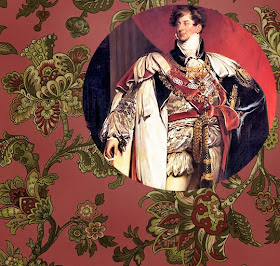Block 15: King’s Crown for the Regent by Becky Brown
King George IV (1762-1830)
Jane Austen’s England was dominated by the fashions of the Regency court. The Regency, in loose terms, means the years after 1788 when Prince George’s father King George III was periodically incapacitated by disease but still ruler. Sticklers define the Regency era as 1811-1820 when the Prince actually had legal power to reign in the King’s stead. The old King died three years after Jane.
George III’s detested son
ruled the ton, set society’s
parameters and depleted the national treasury through most of Jane’s life time. Jane, like most proper Britons, was disgusted by the Prince’s reputation.
The Royal Pavilion, built between 1787 and 1823 at the seaside resort of
Brighton, is one of the Prince's ostentatious accomplishments.
Dorothea Jordan, 1801 by
John Russell
During the Regency, high society’s standards were remarkably low with George and
his brothers openly keeping mistresses such as the actress Mrs. Jordan. With future King William IV, Mrs. Jordan had ten illegitimate children. Distaste for the actress's morals, however, did not keep Jane from enjoying Mrs. Jordan’s performance in the play Decadence.
Harriet Wilson was a Regency courtesan famous,
if not for her charms, for her tell-all autobiography.
Jane wrote Cassandra she'd had a good view of "an Adulteress" at a ball in 1801, perhaps Miss Wilson.
The later Victorians looked back on the Regency era
as a "vortex of dissipation," a phrase Jane's niece Anna tried out
in a novel, one Jane suggested deleting.
King’s Crown by Dustin Cecil
Hugh Bonneville playing George IV
in full makeup.
Could the arsenic in the makeup
Have contributed to the royal family's illnesses?
King's Crown by Bettina Havig
Bettina added a Broderie Perse appliqued flower to the center.
The Prince may have been a laughingstock for his foppish and
fat appearance, but he had the good taste to appreciate Jane’s fiction, and was
reported to keep a set of her novels at each of his houses.
At royal request, she reluctantly dedicated Emma to him.
King's Crown, given that name in the 1930s by the syndicated Nancy Page quilt column, can recall the precarious reputation of the monarchy during Jane's lifetime.
King’s Crown by Becky Brown
King's Crown, given that name in the 1930s by the syndicated Nancy Page quilt column, can recall the precarious reputation of the monarchy during Jane's lifetime.
BlockBase #2054a
Cutting a 12” Block
A– Cut 4 squares 2-1/2”
B - Cut 8 light squares and 4 background
squares 2-7/8”. Cut each in half with a diagonal cut to make 2 triangles.
You need 16 light triangles and 8
background.
C – Cut 1 square 5-1/4”. Cut into 4
triangles with 2 diagonal cuts.
D - Cut 2 squares 4-7/8”. Cut each in half
with a diagonal cut to make 2 triangles.
You need 4 triangles.
E- Cut 1 square 6-1/8”.
Sewing
Mrs Jordan and the Duke of York with a few of their many children.





















No comments:
Post a Comment